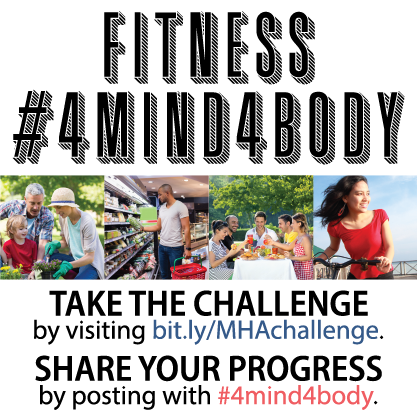You are here
Fitness 4Mind4Body: Exercise

Staying active can benefit so many aspects of your health and can even prevent physical and mental health symptoms from worsening. It’s important to incorporate exercise daily to ensure your body and your mind are healthy.
Exercising Benefits Nearly All Aspects Of A Person’s Health
In addition to helping control weight, it can improve the chances of living longer, the strength of bones and muscles, and your mental health.1

When A Person Doesn’t Get Enough Exercise, They Are At Increased Risk For Health Problems
These include cardiovascular disease, high blood pressure, type 2 diabetes, some cancers, and metabolic syndrome.2

Exercise Increases A Variety Of Substances That Play An Important Role In Brain Function
 |
BDNF (brain derived neurotrophic factor) is a protein that creates and protects neurons (nerve cells) in the brain helps these cells to transmit messages more efficiently, and regulates depression-like behaviors.3,4 |
 |
Endorphins are a type of chemical messenger (neurotransmitter) that is released when we experience stress or pain to reduce their negative effects and increase pleasure throughout the body.5 Endorphins are also responsible for the euphoric feeling known as a “runner’s high” that happens after long periods of intense exercise. |
 |
Serotonin is another neurotransmitter that increases during exercise. It plays a role in sending messages about appetite, sleep, and mood.6 It is the target of medications known as SSRIs or SNRIs, which are used to treat anxiety and depression. |
 |
Dopamine is involved in controlling movement and the body’s reward response system. Due to its role in how the body perceives rewards, it is heavily involved with addictions. When amounts of this chemical messenger are low, it is linked to mental health conditions including depression, schizophrenia, and psychosis.7 |
 |
Glutamate and GABA (gamma-amino butyric acid) both act to regulate the activity of nerve cells in the parts of the brain that process visual information, determine heart rate, and affect emotions and the ability to think clearly.8 Low levels of GABA have been linked to depression, anxiety, PTSD, and mood disorders.9 |
Exercise Can Help Prevent Mental Illnesses And Is An Important Part Of Treatment
| Just 1 hour of exercise a week is related to lower levels of mood, anxiety, and substance use disorders.10 |  |
Among people in the U.S., those who make regular physical activity a part of their routines are less likely to have depression, panic disorder, and phobias (extreme fears).11 |
| One study found that for people with anxiety, exercise had similar effects to cognitive behavioral therapy in reducing symptoms.12 |  |
For people with schizophrenia, yoga is the most effective form of exercise for reducing positive and negative symptoms associated with the disorder.13 |
How Much Exercise Should You Be Getting?
 |
Exercise doesn’t have to be done for hours on end. Ten minutes of moderate or vigorous activity at a time, fifteen times a week will get you to the recommended amount. |
| Muscle strengthening activities should be incorporated into your exercise routine twice a week. This includes yoga, lifting weights, resistance band exercises, and things like push-ups and sit-ups. Your muscles should be tired by the time you are finished with your exercises, but make sure you aren’t trying to lift too much too soon, or you could injure yourself. |  |
You don’t have to have a gym membership to make exercise a part of your life! Picking physical activities that are easy to incorporate into things you already do and having a strong social support system are important in incorporating exercise into your routine.

Join Mental Health America this May as we challenge ourselves to make small changes – both physically and mentally – to create hug gains for our overall health and wellbeing.

If you are taking steps to live a healthy lifestyle but still feel like you are struggling with your mental health, visit www.mhascreening.org to check your symptoms. It’s free, confidential, and anonymous. Once you have your results, we'll give you information and help you find tools and resources to feel better.
Sources
1https://www.cdc.gov/physicalactivity/basics/pa-health/index.htm
2Ibid.
3Sleiman SF, Henry J, Al-Haddad R, El Hayek L, et.al. (2016). Exercise promotes the expression of brain derived neurotrophic factor (BDNF) through the action of the ketone body β-hydroxybutyrate. eLife, 5, e15092. http://doi.org/10.7554/eLife.15092
4Vithlani M, Hines RM, Zhong P, Terunuma M, et.al. (2013). The Ability of BDNF to Modify Neurogenesis and Depressive-Like Behaviors Is Dependent upon Phosphorylation of Tyrosine Residues 365/367 in the GABAA-Receptor γ2 Subunit. The Journal of Neuroscience. 33(39):15567–15577. http://doi.org/10.1523/JNEUROSCI.1845-13.2013
5Bortz WM, Angwin P, Mefford IN. Catecholamines, dopamine, and endorphin levels during extreme exercise. (1981). New England Journal of Medicine. 305:466–467
6Young SN. How to increase serotonin in the human brain without drugs. (2007). Journal of Psychiatry & Neuroscience. 32:394-9.
7Grace AA. (2016). Dysregulation of the dopamine system in the pathophysiology of schizophrenia and depression. Nature Reviews. Neuroscience. 17(8), 524–532. http://doi.org/10.1038/nrn.2016.57
8Maddock RJ, Casazza GA, Fernandez DH, Maddock MI. Acute Modulation of Cortical Glutamate and GABA Content by Physical Activity. (2016). Journal of Neuroscience. 36(8):2449. DOI: 10.1523/JNEUROSCI.3455-15.2016
9Streeter CC, et al. Effects of yoga on the autonomic nervous system, gamma-aminobutyric-acid, and allostasis in epilepsy, depression, and post-traumatic stress disorder. (2012). Medical Hypotheses. 78:571-9.
10Ten Have M, de Graaf R, Monshouwer K. Physical exercise in adults and mental health status findings from the Netherlands mental health survey and incidence study (NEMESIS). (2011). Journal of Psychosomatic Research. 71(5):342–348. https://doi.org/10.1016/j.jpsychores.2011.04.001
11Goodwin RD. Association between physical activity and mental disorders among adults in the United States. (2003). Preventative Medicine. 36(6):698–703. https://doi.org/10.1016/S0091-7435(03)00042-2
12Wipfli BM, Rethorst CD, Landers DM. The anxiolytic effects of exercise: a meta-analysis of randomized trials and dose-response analysis. (2008). Journal of Sport and Exercise Psychology. 30(4):392–410.
13Vancampfort D, Vansteelandt K, Scheewe T, Probst M, Knapen J, De Herdt A, et al. Yoga in schizophrenia: a systematic review of randomised controlled trials. (2012). Acta Psychiatrica Scandinavica. 126(1):12–20.








this page